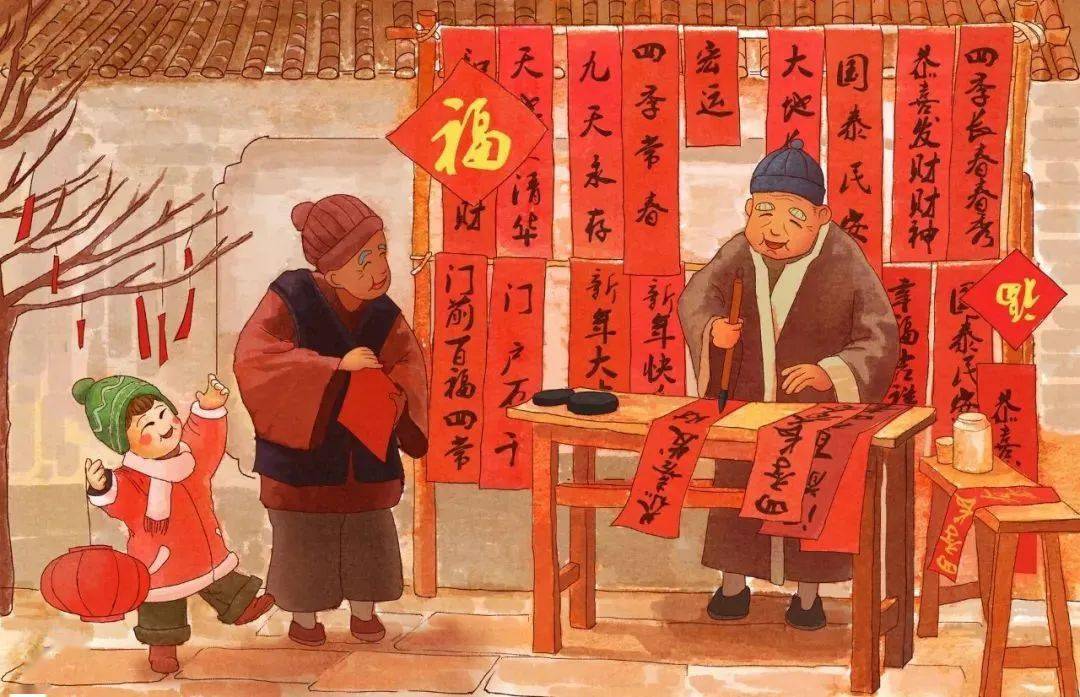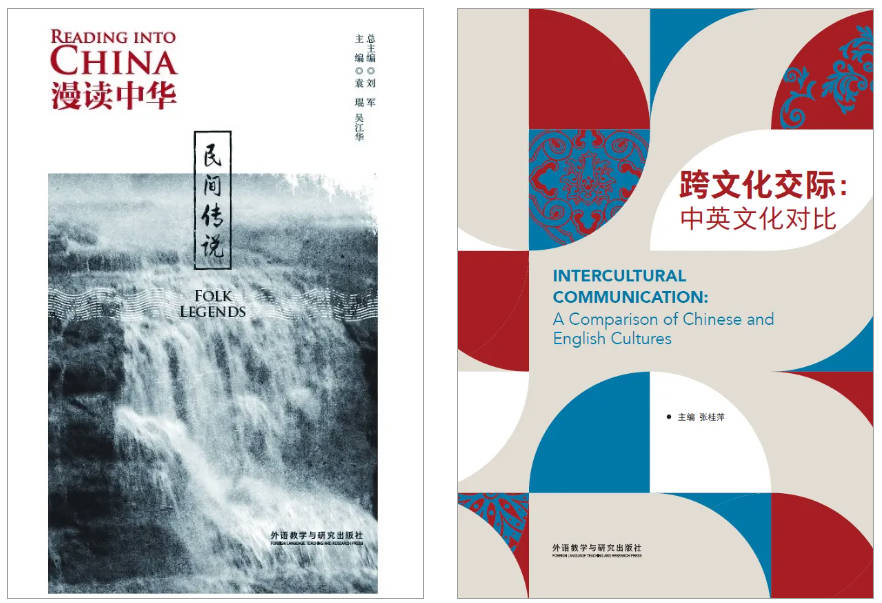双语 | 今日腊八,“腊”么多事都要开始准备起来啦!
2024/01/19
当下已是腊月,离年日近,
新年就要来临,小编先考考您:
“倒贴福”用英文怎么解释?
吃饺子有什么寓意?
吃年糕有什么寓意?
一起从下文中找答案吧!
万事开头难
更别提过年这大阵仗了
先别急,咱们先来个启动仪式:
腊八节是中国春节的开端,古人祭祀祖先和神灵、祈求丰收吉祥,一些地区还有喝腊八粥、做腊八蒜、吃腊八面等食俗。如今的腊八,人们借着一碗腊八粥感受着年味儿,也期盼着亲人的团聚和幸福美满。
The Laba Festival, falling on the 8th day of the 12th lunar month, is a traditional Chinese festival worshiping harvest and marking the start of the Chinese New Year celebrations. The day is commonly celebrated by cooking and eating laba congee made of various components to pray for a good harvest and good fortune.

腊八粥的原料除了美味,还有着丰富的文化内涵。比如,红豆(red beans)代表相思(the feeling of longing for the beloved),莲子寓意多子(fertility),大枣(jujubes)代表吉祥如意(auspicious),龙眼(longans)则表示富贵兴旺(prosperity and wealth),这一碗粥可谓承载着千万寄托,主打一个万事“粥”全!
喝碗文火慢熬的腊八粥,泡罐儿颗颗饱满的腊八蒜。浓浓的年味儿从一碗粥的香味中蔓延开来,忙碌而又乐意无穷的春节即将进入快车道,“腊”么多事都要开始准备起来啦!
“腊”些事之祭灶
腊月二十三是北方的小年。过小年,不论南北,普遍的习俗是祭灶神和扫房子。这一天还会有“糖瓜”“麻糖”等糖果出售,民间传说里,大家希望灶神上天“多言好事”,至少别说家里的坏话,于是用糖瓜粘住了他的嘴。我们所说的“忙年”,也正是从这天开始的。
On the day of Preliminary Eve (the 23rd day of the 12th lunar month), people buy some sweets made of malt sugar, such as tanggua and guandong candy, to sacrifice to the Kitchen God. The purpose is to make him say more good things when he reports to the Jade Emperor. In addition, it also has the intention of sticking the mouth of the Kitchen God with sugar to prevent him from saying bad things. But nowadays, most families make delicious food to enjoy themselves.

(图源网络)
“腊”些事之扫舍去尘
按民间的说法,因“尘”与“陈”谐音,新春扫尘有“除陈布新”的涵义,其用意是要把一切穷运、晦气统统扫出门。这一习俗寄托着人们破旧立新的愿望和辞旧迎新的祈求。
Before the Chinese New Year comes, people completely clean the indoors and outdoors of their homes as well as their clothes, bedclothes and all their utensils. In Chinese, the pronunciation of “尘” (dust) and “陈” (stale things) are the same, so cleaning the dust before the Spring Festival Eve means kicking poverty and bad luck out of the house. The tradition embodies people’s hope to bid farewell to the old and usher in the new.

(图源:中国网)
“腊”些事之置办年货
清扫完房屋后,人们会去购物,大到家具,小到盘子,都要换新。中国人认为,新的一年,就应该置办新物件,做好迎接新事物、新开始的准备。
After cleaning, people will go shopping, from a new piece of furniture to a new plate. Chinese people believe that since this is a year anew they should buy a lot of new things. Purchasing new items symbolizes welcoming new things and getting ready for a new start. A variety of foods are sure in their shopping list. Meat, vegetables, fruits are must, while candies and nuts are popular items which are later seen on the tea table of every Chinese household.

(图源网络)
置办年货是中国老百姓的头等大事,家家户户开始采购各种吃的、穿的、用的、玩儿的,这些被统称为“年货(special purchases for the Spring Festival)”,而采购年货的过程称为“办年货(do Spring Festival shopping)”。
“腊”些事之装点新春
装点房屋是我国新年庆典的一大特色。人们将传统的剪纸贴在窗户上作为装饰。剪纸用的纸通常是红色的,它们内容丰富,包括花鸟鱼虫、山水风景。人们也会用浓墨书写的对联来装饰正门,寓意生机焕发和大地回春。
Decorations are an important feature of the celebration for the Chinese New Year. The traditional Chinese paper-cuts are pasted on windows for decoration. The paper used for paper-cuts is usually of red colour; and the figures may include birds, beasts, flowers, fish and scenery. Chinese families also decorate their front doors with couplets of calligraphy written with fragrant ink, expressing the feeling of life’s renewal and the return of spring.

(图源网络)
除了在大门两侧和上方贴对联外,还会贴一些用书法写的“春”“财”“福”等汉字。一些人会把这些字画倒着贴,因为“倒”在中文里是“到”的谐音,意味着春天、财富或福气已经到来。
In addition to pasting couplets on both sides and above the main door, it is also common to hang calligraphic writing of the Chinese characters for “spring”, “wealth”and “blessing”. Some people even invert the drawings of the characters since the Chinese for “inverted” is a homonym in Chinese for “arrive”, thus signifying that spring, wealth or blessing has arrived.
“腊”些事之年夜饭
大年三十除夕夜,家家户户灯火通明,享用丰盛的年夜饭。鸡肉、鱼和豆腐是必备菜肴,因为它们在中文中分别是“吉”“余”“都福”的谐音,寓意吉祥如意、年年有余、福气安康。
Houses are brightly lit and a sumptuous family dinner is served on the Spring Festival Eve. Dishes such as chicken, fish and tofu must be included, for in Chinese, their pronunciations, respectively ji, yu and doufu are same with those of the Chinese characters which mean “auspicious, abundant and blessed”.

(图源网络)
南方人吃年糕,寓意生活工作“年年高”。北方人吃饺子,一是因为腊月三十夜的23时至新年正月初一的凌晨1时,正是交子之时,取“更岁交子”之意,寓意“辞旧迎新”。二是饺子形似古时候的金锭,一盆盆端上桌来,还象征着“新年大发财,元宝滚进来”。
In southern China, people eat niangao (New Year cake made of glutinous rice flour). Niangao means “higher and higher, one year after another”. In northern China jiaozi, or dumplings, are eaten as people believe jiaozi means “bidding farewell to the old and ushering in the new”. The shape of the dumpling is reminiscent of gold nuggets from ancient times. People eating them wish for money and treasure.
(以上部分文字选自《中国文化概况》(修订版))
综合来源:21世纪英文报、中国日报双语新闻、中国文化网
这一罗列,接下来要筹备的事情还不少咧!但能够和家人朋友一起为新年做准备便是莫大的幸福。值此腊八佳节,小编祝您平安喜乐,团圆美满,万事“粥”全!
当当当,敲黑板!
你想了解更多中国文化的英语表达吗?
你想轻松拿下大学英语四六级翻译吗?
你想成为语通中外的国际传播人才吗?

心动不如行动
快来选购外研社英语文化类图书吧!

扫描二维码进入外研社旗舰店,
搜索相应书名即可购买!





